The Role of Reverse Engineering in the Development of Generic Formulations
Being the first to gain the most is a fundamental principle in the generics business because several companies compete to create generics of successful products going off patent. For a generics company to maintain revenue growth in a market in which product prices continue to fall, it must secure a continuous flow of new products, with quality and speed to market being key drivers. Thus, generics companies must be highly skilled in product and process development (1), the generics business, and achieving bioequivalence-the most critical development area.
Being the first to gain the most is a fundamental principle in the generics business because several companies compete to create generics of successful products going off patent. For a generics company to maintain revenue growth in a market in which product prices continue to fall, it must secure a continuous flow of new products, with quality and speed to market being key drivers. Thus, generics companies must be highly skilled in product and process development (1), the generics business, and achieving bioequivalence—the most critical development area.
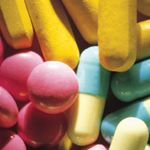
Comstock
Most generics are oral solid dosage forms (e.g., tablets and capsules) that are composed of various excipients, each having a specific purpose (2). Although excipients are clinically inactive, they are pharmaceutically active and, therefore, can affect all aspects of drug product performance (3). For example, functional excipients such as stabilizers and dissolution modifiers contribute to the dissolution and bioavailability of drug products. Determining the original drug's excipient content and other formulation optimization steps can be facilitated using reverse engineering, which is the decoding of an innovator product's formulation parameters. Such parameters include the quantitative composition of the innovator product, the solid-state characterization of the active pharmaceutical ingredient (API), and the manufacturing process.
Although some information about an innovator drug product's API and excipient components can be found in common sources such as product information brochures, Physician's Desk Reference, or FDA's Web site (www.fda.gov), one can be more confident about the generic product's performance by developing a formula that is as qualitatively and quantitatively similar to the reference listed drug (RLD) as possible. Under US law, quantitative information about the excipients in oral dosage forms is not required to be revealed. In this context, reverse engineering of the innovator product's formulation is a scientifically sound and cost-effective strategy for accelerating generic product development. From a practical perspective, the chances of developing a bioequivalent product can be significantly increased by extending the concept of generic product sameness to formulation sameness with the RLD. Generic product sameness is defined in terms of pharmaceutical equivalence and bioequivalence. Formulation sameness with the RLD is defined in terms of equivalence of qualitative and quantitative formulas, solid state characteristics, and manufacturing process to the RLD (see Sidebar, "Generics terminology").
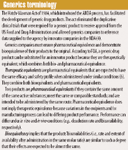
Generics terminology
Though generics companies have used reverse engineering for quite some time, the topic is scarcely covered in the published literature. In this article, we discuss the importance of reverse engineering and propose a decision-making process for developing solid oral dosage forms. We suggest various components of reverse engineering and the tools needed to carry out the process. The method is based on information generated from a series of reverse engineering experiments on RLD products (4).
Components of reverse engineering
Decoding the quantitative formula. Decoding an RLD's quantitative formula should begin with identifying which excipients most affect the formulation's performance in quality tests (i.e., stability or dissolution). These data will provide information about the resources required for reverse engineering versus the importance of the information derived. Resources (e.g., time and money) can be streamlined on the basis of these findings because sometimes traditional formulation optimization techniques may be more efficient than reverse engineering. In general, pH-adjusting agents, buffers, stabilizers (e.g., antioxidants and chelating agents), and dissolution modifiers (e.g., surface active agents) are the best candidates for reverse engineering.
The next step is to quantify an identified excipient in the tablet matrix, which is challenging because of possible interference from the other excipients. Hence, the excipient must first be separated from the tablet matrix using techniques such as differential solubility, filtration (with filters of a specific pore size or molecular weight cutoff), high-performance liquid chromatography (HPLC), high-performance thin-layer chromatography (HPTLC), and size-exclusion chromatography. One must select the separation technique based on the number of interfering components present and their physicochemical properties.
After separation, quantification must be performed using a gravimetric or detection tool such as ultraviolet (UV)-visible light, the refractive index, an evaporative light-scattering detector for HPLC, or spectroscopic techniques (e.g., infrared attenuated transmittance reflectance or near-infrared [NIR] spectrometry). Gravimetry is best suited for quantifying major excipients of significant weight in the dosage unit. Components present in small quantities such as stabilizers, surfactants, and pH-modifying agents are best quantified using sophisticated separation and quantification techniques such as HPLC and HPTLC. High molecular weight excipients such as widely used polymers can be effectively quantified using size-exclusion chromatography.
Solid-state characterization of API. The API's solid-state properties can be categorized as molecular, particle, or bulk (see sidebar, "Importance of solid-state properties for pharmaceuticals"). The molecular level encompasses properties such as crystalline forms, hydrates, solvates, and amorphous forms. Differences among the intermolecular arrangements and free energy distinguish these forms in solubility, manufacturability, bioavailability, and stability (5). These factors are critical when characterizing the RLD's API solid form during the development of generic products.
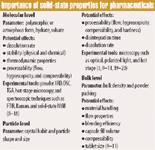
Importance of solid-state properties for pharmaceuticals
With respect to generic drug development and abbreviated new drug applications (ANDAs), polymorphism has been discussed thoroughly in recent publications (6). In the context of the regulatory requirements, the statutory provisions do not require the sponsor of an ANDA to demonstrate that the API in the generic product and the innovator product "exhibit the same physical characteristics and that the solid-state forms of the drug have not been altered" (7). Thus, solid polymorphism is not a relevant issue to demonstrate the basis of drug substance sameness in an ANDA.
In a practical context, the innovator product is usually developed using the most stable polymorphic form to avoid transformation complications during processing and storage. To be safe, generics companies should use the same polymorphic form as the RLD to ensure a similar stability and dissolution profile. At times, such a strategy will be blocked because a valid patent on the polymorphic form extends beyond the expiry of the basic molecule patent. In this instance, one must file under paragraph IV certification (505 [j] [2][A][vii]) and use an alternative solid form to develop the generic product. Various techniques such as powder X-ray diffraction, Fourier transform IR, NIR, and Raman spectroscopy; differential scanning calorimetry; and themogravimetric analysis may be used to characterize solid forms. Detecting and quantifying polymorphic mixtures in the dosage unit may be required. This procedure can be conducted more effectively using powder X-ray diffraction because other techniques tend to exhibit interference from the tablet matrix.
Particle-size reduction or micronization is a common method used by pharmaceutical companies to improve the dissolution rate of poorly water-soluble drugs. API particle-size distribution—which directly affects bioavailability and dissolution rate—helps ensure a bioequivalent formulation, especially for drugs having dissolution-sensitive bioavailabilities. Thus, the information generated from the API's particle-size distribution in the innovator product is critical in ensuring dissolution and bioequivalence. The challenge herein lies in determining the API's particle size in the presence of other excipients. Routine particle-sizing techniques based on light obscuration and laser scattering will not be applicable because of their inability to differentiate between the API and excipient particles. The only feasible technique is microscopy.
Microscopy can differentiate APIs from excipients on the basis of characteristics such as particle shape and birefringence patterns. Under polarized light, crystalline drugs exhibit birefringence patterns whereas many excipients are noncrystalline and therefore do not exhibit a birefringence pattern. Hot-stage microscopy can be supplemented with optical microscopy to confirm the API particles are identified according to their melting points. Thus, identifying and characterizing the original drug's API at the molecular and particle levels accelerates decision making and minimizes developmental and regulatory approval time.
Identifying the manufacturing process. Solid oral dosage forms can be manufactured using wet granulation, dry granulation, or direct compression, depending on the API's stability profile, API–total tablet weight ratio, and physicotechnical properties (e.g., flow properties and compressibility of the major ingredients). In addition to processability, the manufacturing technique can affect the drug's stability and performance in the in vitro and in vivo environment (i.e., dissolution and bioavailability).
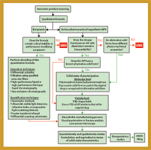
Figure 1: Decision tree for reverse engineering a tablet formulation.
The process used to manufacture the RLD can be predicted on the basis of the API's physicochemical profile—the wet granulation process will not be feasible for water-sensitive APIs or it may be difficult to achieve and confirm the blend uniformity of a very low-dose API in a direct-compression method. Visual examination of the tablet fracture provides some idea about the granulation technique. Wet or dry granulation produce fractures that are rougher than those produced by direct compression. The tablet can be put in a petri dish containing water, and the disintegration pattern can be examined under a low-power optical microscope. Tablets prepared using direct-compression disintegrate into individual particles, whereas tablets prepared by wet or dry granulation disintegrate into particle agglomerates (granules). This information can be grouped with the qualitative formula to finalize the excipients' roles in the dosage form. Some excipients such as hydroxypropyl methylcellulose, starch, and lactose can have multiple roles in the final dosage form. Thus, it may be difficult to assign them a functionality initially by solely examining the qualitative formula.
Protocol for reverse engineering
Figure 1 shows a decision tree for performing reverse engineering on a tablet dosage form. The functionality of the excipient and the API's physicochemical properties strongly affect the amount of effort needed for reverse engineering to be successful.
A judiciously performed reverse engineering exercise can facilitate the decision-making process at various stages of product development (see Figure 2). During Stage 1, information about the API's solid form can expedite the identification of meaningful specifications and the selection of suitable vendors. Similarly, a highly truncated preformulation study protocol is needed for generic products that are qualitatively and quantitatively similar to the RLD.
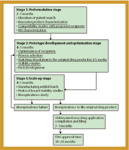
Figure 2: A typical generic formulation development pathway. Underlined activities are directly affected by reverse engineering.
Stage 2 will have the most perceptible effect on reverse engineering. Quantitative information about key ingredients will simplify prototype formulation optimization. A traditional approach involves making several prototypes of varying compositions and testing them for performance and stability.
Decoding the quantitative details would drastically reduce the number of experiments required to reach the optimal formulation. Thus, the decision-making process becomes objective because of reduced dependence on experimental observations such as the dissolution profile, which, though a useful tool, does not ensure a bioequivalent product. Much higher confidence about the bioequivalence can be obtained by developing a quantitatively similar product based on reverse engineering and ensuring a dissolution profile similar to the RLD. In the same way, proactive solid-state characterization of the API in the RLD would reduce risks along the developmental pathway, especially for products containing molecules in which the bioavailabilities are sensitive to dissolution.
Conclusion
Cost and speed to market are keys to success for a generics pharmaceutical company. Achieving bioequivalence to the RLD is a critical part of development, and the chance of biofailures must be reduced. Reverse engineering is a useful tool for developing generic products to better ensure bioequivalence. A sound reverse-engineering strategy that encompasses the decoding of the RLD's quantitative formula, the solid-state characterization of the API, and the manufacturing process may reduce development timelines and cost.
Arvind K. Bansal* is an associate professor and Vishal Koradia is a research fellow the Department of Pharmaceutical Technology (Formulation), National Institute of Pharmaceutical Education and Research, Sector 67, SAS Nagar, Punjab 160 062, tel. 191 172 2214682, fax 191 172 2214692, akbansal@niper.ac.in
*To whom all correspondence should be addressed.
References
1. J.-M. Peny, "How Bright Is the Future for Generics?" Scrip Magazine 122, 13–17 (2003).
2. P. York, "Solid-State Properties of Powders in the Formulation and Processing of Solid Dosage Forms," Int. J. Pharm. 14 (1), 1–28 (1983).
3. M.N. Martinez and G.L. Amidon, "Mechanistic Approach to Understanding the Factors Affecting Drug Absorption: A Review of Fundamentals," J. Clin. Pharmacol. 42 (6), 620–643 (2002).
4. V. Koradia, G. Chawla, and A.K. Bansal, "Comprehensive Characterization of the Innovator Product: Targeting Bioequivalence Generics," J. Generic Med. (in press).
5. S.R. Byrn et al., "Pharmaceutical Solids: A Strategic Approach to Regulatory Considerations," Pharm. Res. 12 (7), 945–954 (1995).
6. A.S. Raw et al., "Regulatory Considerations of Pharmaceutical Solid Polymorphism in Abbreviated New Drug Applications (ANDAs)," Adv. Drug Del. Rev. 56 (3), 397–414 (2004).
7. FDA, Federal Register 57, 17958–17959 (April 28, 1992).
8. J.K. Haleblian, "Characterization of Habits and Crystalline Modification of Solids and their Pharmaceutical Applications," J. Pharm. Sci. 64 (8), 1269–1288 (1975).
9. D.J.W. Grant, "Theory and Origin of Polymorphs," in Polymorphism in Pharmaceutical Solids, H.G. Brittain, Ed. (Marcel Dekker, New York, NY, 1999), pp. 1–33.
10 . D. Giron, "Thermal Analysis and Calorimetric Methods in Characterisation of Polymorphs and Solvates," Thermochim. Acta. 248, 1–59 (1995).
11. D. Giron, "Contribution of Thermal Methods and Related Techniques to the Rational Development of Pharmaceuticals: Part 1," Pharm. Sci. Tech. Today 1 (5), 191–199 (1998).
12. J. Bauer et al., "Ritonavir: and Extraordinary Example of Conformational Polymorphism," Pharm. Res. 18 (6), 859–866 (2001).
13. W. Liebenberg et al., "Identification of the Mebendazole Polymorphic Form Present in Raw Materials and Tablets Available in South Africa," Drug Dev. Ind. Pharm. 24 (5), 485–488 (1998).
14. R.J. Terblanche et al., "Characterization of Zopiclone Crystal Forms among Generic Raw Materials," Drug. Dev. Ind. Pharm. 26 (5), 531–537 (2000).
15. N.V. Phadnis and R. Suryanarayanan, "Polymorphism in Anhydrous Theophylline: Implications on the Dissolution Rate of Theophylline Tablets," J. Pharm. Sci. 86 (11), 1256–1263 (1997).
16. S.Q. Henwood et al., "Solubility and Dissolution Properties of Generic Rifampicin Raw Materials," Drug Dev. Ind. Pharm. 26 (4), 403–408 (2000).
17. A. Kristl et al., "Polymorphism and Pseudopolymorphism: Influencing the Dissolution Properties of the Guanine Derivative Acyclovir," Int. J. Pharm. 139 (1–2), 231–235 (1996).
18. B.C. Hancock and G. Zografi, "Characteristics and Significance of the Amorphous State in Pharmaceutical Systems," J. Pharm. Sci. 86 (1), 1–12 (1997).
19. E. Swanepoel et al., "Dissolution Properties of Piroxicam Powders and Capsules as a Function of Particle Size and the Agglomeration of Powders," Drug. Dev. Ind. Pharm. 26 (10), 1067–1076 (2000).
20. M. Otsuka, M. Nakanishi, and Y. Matsuda, "Effects of Crystalline Form on the Tableting Compression Mechanism of Phenobarbital Polymorphs," Drug. Dev. Ind. Pharm. 25 (2), 205–212 (1999).
21. M.V. Dali and J.T. Carstensen, "Effect of Change in Shape Factor of a Single Crystal on its Dissolution Behavior," Pharm. Res. 13 (1), 155–162 (1996).
22. A.K. Tiwary and G.M. Panpalia, "Influence of Crystal Habit on Trimethoprim Suspension Formulation," Pharm. Res. 16 (2), 261–265 (1999).
22. S. Sun and D. J. W. Grant, "Influence of Crystal Structure on the Tableting Properties of Sulfamerazine Polymorphs," Pharm. Res. 18 (3), 274–280 (2001).
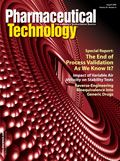
Pharmaceutical Tariffs Are Imminent: How Industry is Bracing for Impact
April 16th 2025On April 14, 2025, the Trump Administration launched a national security-driven investigation into pharmaceuticals, a move that will likely result in tariffs being placed on pharmaceutical drugs, ingredients, and other components that are imported from outside of the United States.
Drug Solutions Podcast: A Closer Look at mRNA in Oncology and Vaccines
April 30th 2024In this episode fo the Drug Solutions Podcast, etherna’s vice-president of Technology and Innovation, Stefaan De Koker, discusses the merits and challenges of using mRNA as the foundation for therapeutics in oncology as well as for vaccines.